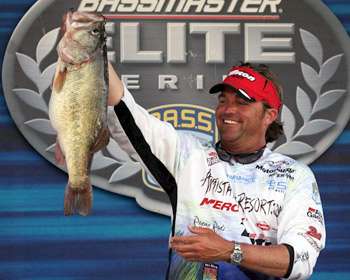
There is perhaps no finer time to pursue bass than in the spring. All of the pent up cabin fever anglers have endured for months finally can be released as the water warms and bass migrate shallow for their annual spawning dance. If you were to poll the participants in this four-part play we call bass fishing, most would agree that their favorite technique during the spring is sight fishing.
However, during the spring it's not all roses — the weather is often unsettled as Old Man Winter slowly releases his grasp. As evidenced by the 2009 season's first Elite Series event at Lake Amistad, pros reported finding droves of shallow spawners during practice, but due to a late-week cold front that passed through, the shallows were vacated.
Elite Series pro Byron Velvick suggests that cold fronts won't necessarily spoil your sight fishing plans. "A lot of times, just because the air temperatures have dropped, the water temps will still be relatively warm," he explains. "At least in that first day of a cold front, you still have an opportunity to go in and find the bed fish that were there."
Velvick contends that in many cases, a committed spawner won't concede ground to the oncoming cold front. "If they're really locked on hard, they're going to stay through it," he says. "Don't abandon the technique because of the forecast or cooler temperatures. Prove to yourself that the bite has dried up before you throw in the towel.
"They won't do anything dramatic like pull all the way back out to the main lake and start over," he says. "They want to go to the nearest deep water or to the nearest drains and hunker down until the system passes and the water starts to warm again."
To relocate the prespawn bass that were forced into a slight retreat, Velvick will back off to the nearest deep water within the spawning bays where he has previously located his biggest concentration of fish. "I know that those were fish that were committed to spawning," he points out.
"I'm going to target the nearest deep-water breaks, or the nearest points — all within that same cove — and find those fish that were recently up shallow."
Bait selection for bed fishing can range from weightless worms and plastic stickbaits to swimbaits. Velvick explains that oftentimes it's not necessary to change baits to search for those shallow fish that recently moved out of the shallows.
"At Amistad, I was still throwing the swimbait, but I was targeting suspended fish that had moved out into the deeper trees along the first breakline," he explains. "I had to forget about everything that I had seen a few days prior, and start focusing on those areas that I felt like the bass had moved to."
Remaining focused on the general area, and forgetting about the beds you may have seen up shallow, will often overshadow bait selection. However, Velvick offers this parting tip regarding bait selection: "The swimbait is such a finicky bait, and you can lose real quick with it," he says. "Often, if you pick up a jig or Texas rigged worm, you can pick apart the breaks and points a lot better.
"The bottom line is to not leave the area that those fish were in."




